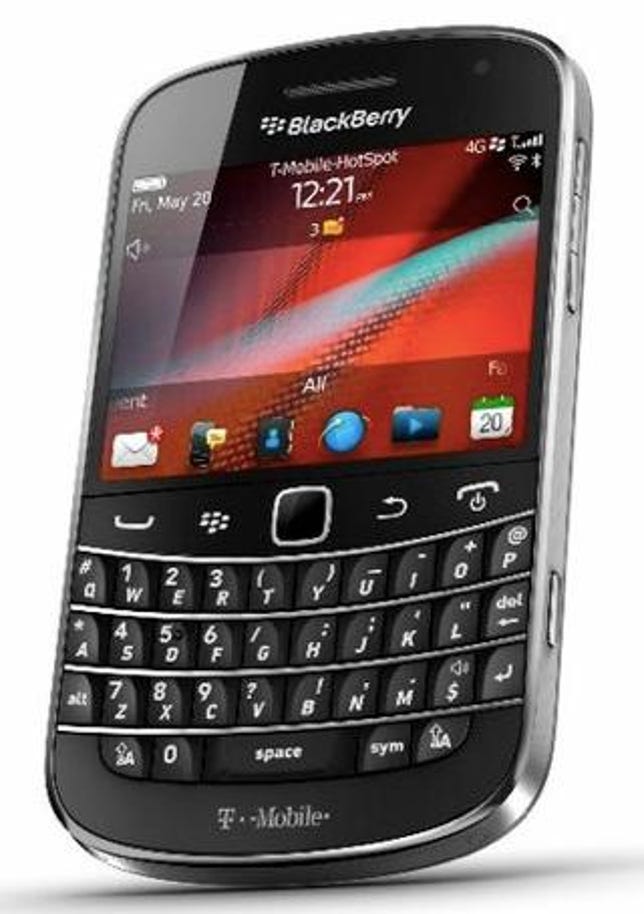Research In Motion reports its fiscal first quarter results on Thursday, and analysts are decidedly gloomy about the company’s prospects.
The big questions: did RIM’s PlayBook tablet launch deliver sales momentum and did that device suck too much wind out of development for other products?

T-Mobile
Reading through the research notes on RIM is a bit depressing. RIM isn’t Nokia, but analysts are frustrated by the company’s delayed products. RIM’s Bold 9900 may not ship until September, and four more devices based on the BlackBerry OS 7, which used to be known as OS 6.1, may not ship until November. At its BlackBerry World conference, RIM had talked about a June or July ship date.
At a time when RIM should be taking away Nokia’s market share it is trying to get much ballyhooed smartphones to market.
Without those devices, RIM is in limbo on the revenue front. And the later those devices come, the more likely RIM’s “superphones,” devices based on the QNX operating system, will slip further into 2012. Morgan Stanley analyst Ehud Gelblum says RIM is mired in a “continued product vacuum.”
In other words, analysts will be closely monitoring RIM executives and trying to read the product tea leaves. As for the quarter, Wall Street has already factored in a disappointment. Analysts are expecting earnings of $1.32 a share on revenue of $5.15 billion following RIM’s recent profit warning.
Gelblum didn’t mince words. He said in a research note:
We believe RIM has now squandered nearly every opportunity and competitive advantage it enjoyed through ineffective R&D resource management, delayed product launches and misreads of the competitive environment. With the 9900 launch now likely pushed out til Sept, the remaining BB7 phones now likely just launching in Oct/Nov, and new Playbook models on the way, we believe RIM may have run out of R&D capacity to launch its QNX handset in the CQ1/ FQ4 timeframe it was shooting for.
Among the key items to watch for RIM:
PlayBook sales. Morgan Stanley is expecting RIM to ship 400,000 PlayBooks in the first quarter and then projects another 700,000 in the second quarter due to international market expansion. In other words, the PlayBook won’t be the iPad, but will have a respectable showing. CIBC analyst Todd Coupland is also projecting sales of 400,000 PlayBooks. Coupland added:
Our view is the PlayBook is a very good product and in spite of a “sloppy launch.” PB appears to have been booking steady sales. Sales above 300,000 units are likely to be viewed as a positive.
When are these new smartphones shipping? Coupland said:
To date, we have only seen scattered blog commentary that RIM’s new products will be delayed for the critical back-to-school selling period. We would like RIM to clarify or at least give some indication as to the progress of major carrier launch dates in order to legitimize the Q2 and F2012 shipment outlook. It would also quicken and improve the ability for RIM to take market share from the struggling Nokia.
Details about these new phones would be nice too. RIM has demonstrated the Touch Bold, but the touch-screen Curve and Torch II are largely mysteries. These details would reveal whether RIM can be competitive with the likes of Apple and HTC as well as continue its international momentum.
Can RIM defend international markets? RIM will take the PlayBook to the international markets where the BlackBerry is strong. What’s unclear is how long RIM can continue to thrive abroad with its product vacuum.
Smartphone units and average selling prices. Gelblum expects RIM to ship 13.5 million smartphones and that sum is largely in line with the consensus. The problem is that RIM is falling behind on smartphones–especially in North America. William Blair analyst Anil Doradla said:
Our latest round of channel checks across North America continue to indicate that RIM is losing market share. Relative to three months ago, the market has become more competitive, with pressure from Android (now including several LTE devices) and continued strength from Apple spreading to Verizon. As a result, RIM did not have a smartphone in the top three position at any of the four major North American operators. Additionally, during the quarter RIM saw significant price cuts at AT&T and Sprint.
Across the board, our checks continue to indicate that sales reps are de-emphasizing the sale of RIM devices, and there is an increasing perception of the brand becoming an “e-mail-only device” designed for the business user.
Indeed, Doradla’s channel checks on RIM are downright alarming at U.S. carriers. At Verizon, the top three phones were Apple’s iPhone, HTC’s Thunderbolt, and Samsung Droid Charge. At AT&T, the iPhone, HTC Inspire, and Samsung Infuse were the top three. Sprint was led by Samsung’s Epic 4G, HTC’s Evo and Google’s Nexus S. T-Mobile’s top three phones were the Samsung Galaxy S, T-Mobile G2x, and MyTouch 4G. All of those carriers as recently as December had RIM devices in the top three spots.
The story was originally posted at ZDNet’s Between the Lines as “Research in Motion: Did PlayBook R&D jeopardize its superphones?”



